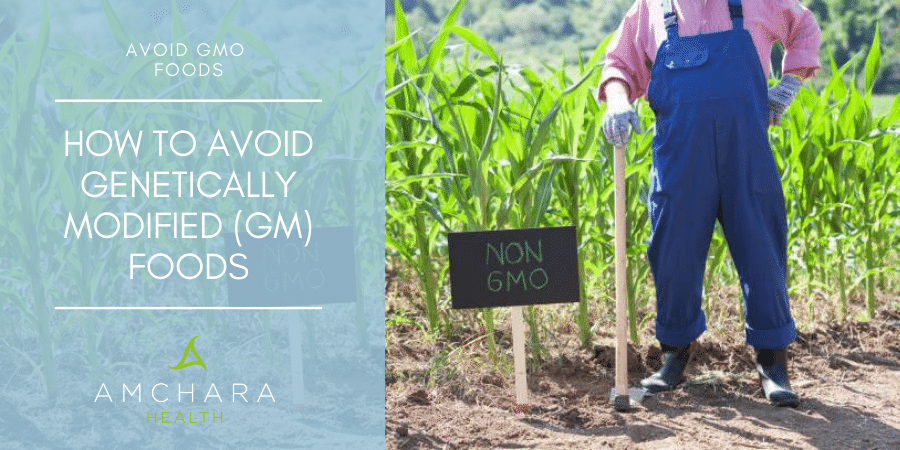In this article:
- What is GM food?
- How widespread is GM food?
- Why are GM crops grown?
- Does GM food adversely affect health?
- Putting profit before health?
- GM and the planet
- How to avoid GM food
- Labelling of GM food
- Takeaway
Over the last couple of decades, Genetically Modified (GM) food has been a hot topic.
Variously touted as the answer to starving world populations and a boon to farming, or a dangerous risk to our health and the planet, the discussion continues.
In the modern internet world there is an overwhelming amount of information and it can be hard for you to find health advice you can trust. This is particularly so as the main media channels are typically dominated by a single, orthodox narrative.
Our mission is to provide you with both insightful information and evidence-based content and we aim to provide you with actionable knowledge and tips to help you on your journey to optimal health.
So let’s take a closer look at GM food and separate fact from fiction.
What is GM food?
Genetically Modified Organisms, or GMOs, are produced by a scientific process which transfers genes from one species to another. Genes carry the instructions for all the characteristics inherited by living things.
Ever since we invented agriculture, we’ve been manipulating food crops. We have selectively bred both plants and animals to make the most of certain traits like colour, size, taste, pest resistance and so on.
However, unlike selective breeding, GM technology combines the DNA of different varieties of the same species.
For example, genes from a plant with good resistance to a specific pest can be used to improve the resistance of a different plant to this pest. In order for this to happen, the gene which is related to the pest resistance has to be isolated from the first plant and inserted into the second plant.
The resulting plant will be resistant to those pests.
Where GM technology differs still further from selective breeding is when genes from one species of organism are inserted into an entirely different species.
So, for example, genetic material from a bacteria resistant to a certain pest could be introduced into potatoes to achieve the same pest resistance.
The way a gene works can also be altered by switching it off. In the case of fruits, the gene involved in making it go soft and mushy could be inhibited. This would mean the fruit could be transported more easily.
Genetic modification causes a whole new organism to be created which has never before existed in nature. The crop plant thus produced can then be patented.
How widespread is GM food?
It is estimated that currently 94% of US-grown soya beans are genetically modified, along with 92% of corn. This is compared to 1997 when just 17% of soya grown was GM.
Around 75% of processed foods now on American shelves are thought to contain GM ingredients.
The most common GM crops include corn, soya, canola, oilseed rape and sugar beet.
These are all ingredients commonplace in many processed foods.
However, crops, as varied as tomatoes to flax seeds, have been the target of genetic modification technology.
A huge amount of GM corn and soya are grown as livestock food.
So the GMOs end up in the meat of the animal and are then eaten by us.
Why are GM Crops grown?
The idea behind genetically modifying a crop is to increase resistance to pests, herbicides or diseases, and to obtain bigger and better crops.
Plants are also genetically modified to look more appealing and attractive to consumers, have a longer shelf life or even to contain different nutrients to those found naturally.
- GM to feed a starving world
The most popular reason for genetically modifying crops is to produce plants which are resistant to otherwise lethal doses of herbicides. They can be doused in specific weed-killers and grown more successfully.
This has resulted in plants known as Roundup Ready which means they can withstand a particular herbicide known as Roundup.
This is manufactured by US agricultural biotechnology company Monsanto, which has recently been taken over by the pharmaceutical company Bayer.
Many of the companies who produce GM food argue they can help to conquer world famine and hunger.
However, although research does show GM crops produce increased yields, it is thought the solution to world hunger doesn’t lie in insufficient food.
Experts believe famine is caused by poor distribution of food. As much as a third of all food produced worldwide is wasted, while many food crops are used to produce biofuel or to go to factory farms.
- Reduction in pesticides
If crops are grown with increased resistance to pesticides, GM-promoters argue less pesticides can then be used, which is surely a good thing?
However, although research has shown growing GM-crops reduces pesticide use in the short term, a problem arises when insect pests become resistant to the genetically modified plant.
This happens after an average of just five years. Pesticides will then need to be used in any case and meanwhile we’ve bred ‘super pests’.
Research shows pesticides are being used over a wider area in the UK, and crops are treated more frequently than 20 years ago.
Does GM food adversely affect health?
The first and perhaps most frightening aspect to consider is that the consequences of eating GMOs in relation to your health are mostly unknown.
Bear in mind GMOs have only been around since 1994. The novel genes they possess are entirely new to evolution.
What’s more, foodstuffs which have been genetically engineered have not been tested over the long term.
This is because studies financed by industry typically last a maximum of 90 days.
Alteration of one gene within a plant is likely to result to alterations in the expression of other genes – but it’s impossible to predict in what way.
One leading developer of GM potatoes such as White Russet has voiced concern that these potatoes accumulate toxins which are absent in non-GM potatoes.
In 2015, over 300 scientists and legal experts signed a statement to the effect that there is ‘no consensus’ on the safety of genetically modified crops and foods.
The studies in existence, however, cast serious doubt on the safety of GM crops.
One study fed pigs GM soy and corn over 22 weeks. The pigs eating the GM diet had a higher rate of severe stomach inflammation than pigs fed a non-GM diet, and the females showed changes in their uterus. (1)
A study on rats eating herbicide-tolerant corn developed mammary tumours, kidney and liver damage and died prematurely. (2)
Almost all the ill effects developed after 90 days. It’s unclear from this study whether the ill effects were caused by the GM corn or the traces of herbicide it contained.
Another study, again on rats, found feeding GM pest resistant corn led to many rats becoming sterile.
Researchers also noted deterioration in markers for kidney and liver function. (3)
Although a quick internet search will reveal many vocal supporters of GM technology despite these findings, one survey in 2010 revealed 95% of European respondents considered GM food to be potentially unsafe and lacking real benefits.
- GM food and our microbiome
Many scientists have voiced concerns over the fact that once GM food enters our body, it can potentially pass on mutated genes into our gut bacteria.
This could be bad news for our health.
One study fed GM soya to human volunteers and found some of the transgenic DNA from the soya made its way into their intestinal bacteria.
This phenomenon wasn’t observed in the case of non-GM soya. (4)
- GM food and allergies
When crops are genetically modified, their proteins interact with our immune system in a different way to those which haven’t been genetically altered. (5)
So it follows GM crops may be behind the huge rise in food allergies since the introduction of GM crops.
21 million of us now suffer from at least one allergy and this figure is increasing by 5% each year.
- GM food and pesticide residue
Many GM crops have been designed to produce their own insecticidal proteins which kill any insect pests eating the plant.
This is done by introducing genes from a soil bacterium known as Bacillus thuringiensis.
Unfortunately as it’s contained inside the plant, it can’t be washed off like normal pesticides.
So GM crops are delivering a dose of pesticides to us which can’t be removed.
Although GM manufacturers assert the bacteria toxin contained in the plant is only hazardous to insects, research suggests it may affect our immune system.
- Herbicide dangers
Obviously, herbicide tolerant plants can be grown using more chemicals, and increasing use of herbicides over the years bears this out.
In Canada, for instance, herbicide sales have increased 199% since GM plants were introduced in 1994.
The herbicide Roundup, which can be used without ill-effects on Roundup Ready GM crops, contains a chemical called glyphosate.
Glyphosate exerts its effect by preventing plants making specific proteins which they need to grow. In research on frog embryos, glyphosate was found to cause birth defects.
In the first of many pending trials in the US, Monsanto was recently fined $289 million for failing to warn users of the now accepted link between glyphosate and cancer, in this case, non-Hodgkin Lymphoma. (6)
The International Agency for Research on Cancer had identified glyphosate as a probable carcinogen back in 2015.
Although glyphosate is licensed to be used in the EU until 2022, certain member states are debating banning its use.
This has led to plants being engineered to be tolerant against different herbicides. The latest to be developed is called 2,4-D which controls weeds by causing cells in unwanted plants to grow uncontrollably.
In 2015 2,4-D was classed by the International Agency for Research on Cancer as a possible human carcinogen.
Also worryingly, many studies have shown this herbicide to act as an endocrine disruptor, adversely affecting hormone balance, especially that of thyroid hormones.
Putting profit before health?
GM technology is not new, and it’s reasonable to ask why independent studies haven’t been carried out to determine its safety.
The problem is, if something is a source of profit, positive messages will be pushed out to encourage people to accept it – whether it be a piece of new technology, a food or even a car. It’s the same with GM crops.
Unfortunately, because GM crops are patented, it makes it hard to study these crops without gaining permission from the patent holder.
This means independent research studies haven’t been widely carried out, and those which have are generally short term and funded by the organisation which has developed the crop.
Back in 2009, the American Academy of Environmental Medicine, an international association of physicians interested in clinical aspects of environmental health, released a paper calling for a temporary prohibition on genetically modified food.
This paper also called for the implementation of immediate long-term safety testing and advised physicians to educate their patients to avoid GM food. (7)
GM food and the planet
Genetically engineered crops are believed to potentially reduce genetic diversity over time. When genes are diverse they tend to be stronger.
We see this throughout nature both in animals and plants. Pure breeds tend to be more prone to more health issues than those containing a good mix of genes.
Just think about the various health problems endured by many pedigree dogs.
So less genetic diversity caused by GMOs being introduced into the food chain could potentially have a negative impact on the planet.
Once altered genes are introduced into a species, there’s no going back – they will continue to be passed on from one generation to the next.
With over 90% of soya grown in the US now genetically modified, and pollen from these plants drifting as pollen does, it’s becoming harder and harder to obtain GM free soya.
Corn is not far behind.
How to avoid GM food
It’s difficult but by no means impossible to avoid GM food.
Labelling of GM food
In the UK, packaging must confirm if any GM products are intentionally included.
EU law has ruled the label must state if the food contains or consists of genetically modified organisms, or if it contains ingredients produced from GMOs.
Meat, milk and eggs from animals fed on GM animal feed do not need to be labelled.
It’s becoming more and more difficult to obtain sufficient crops, especially soya, to fulfil demand without using GM crops, which is why some UK supermarkets have switched to selling chicken which has been fed with GM feed.
Food produced using agents produced by GM technology also currently doesn’t have to be labelled.
For example, cheese may be produced using genetically modified enzymes which clot the milk.
In the USA, GMOs still aren’t labelled, however following pressure from consumers labelling will now be introduced from 2020.
UK labelling laws relate only to intentional inclusion of GM ingredients.
Much non-GM produce is accidentally contaminated with GMOs through cross-pollination.
A tolerance threshold of 0.9% per ingredient is allowed without it having to be labelled. For Soil Association approved organic food, the threshold is much lower at 0.1%.
Takeaway
If you want to avoid GM food, your best policy is to avoid processed foods and shop organic.
Most GM-crops are destined for manufacturers of processed food, so by cooking with whole foods, you will lessen your exposure.
If you eat meat, then eating GM-free may be more difficult as you will then need to be satisfied the ingredients for the animal’s feed are from a non-GM source.
Meat certified as organic can’t be fed GM-food. It’s best to opt for wild-caught fish over farmed fish – there are plans to feed farmed salmon GM-corn.
We always recommend eating organic whole foods. By doing this you’ll benefit not only your health but also the planet.
This doesn’t need to be the end of the article. With your help let’s continue the conversation.
What do you think about GM food?
We’d love to hear your thoughts.
Read this next:




